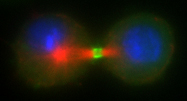Submitted by Administrator on Fri, 13/12/2013 - 11:11
17 November 2013
Dr Paolo D’Avino’s group published in The Journal of Cell Biology about the regulation of the small RhoA GTPase during cytokinesis.
This study originates from the long-standing interest of Dr D’Avino in the mechanisms that control the last phase of cell division, cytokinesis. The first author of the paper is a PhD student who joined the group of Dr D’Avino in October 2010.
The proper segregation of genomic and cytoplasmic material during cell division is crucial for growth, development and  reproduction in many organisms, including humans. Failure in this process can cause genetic diseases such as Down’s syndrome, anaemia, sterility and cancer. Therefore, a thorough understanding of the mechanisms that control cell division may lead to the development of novel therapeutic treatments for these genetic diseases.
reproduction in many organisms, including humans. Failure in this process can cause genetic diseases such as Down’s syndrome, anaemia, sterility and cancer. Therefore, a thorough understanding of the mechanisms that control cell division may lead to the development of novel therapeutic treatments for these genetic diseases.
The final step of cell division, cytokinesis, ensures that the two daughter cells become physically separated, avoiding the formation of polyploid cells. Cytokinesis requires the assembly and ingression of a cleavage furrow that bisects the mother cell. In many organisms, the force that drives furrow ingression is the assembly and contraction of actomyosin filaments that often form a contractile ring. Compelling evidence indicates that the small GTPase RhoA controls contractile ring assembly and dynamics during cytokinesis by activating different effectors. One of these putative effectors is the serine/threonine kinase Citron kinase, which has been thought for more than a decade to phosphorylate the myosin regulatory light chain (MRLC) upon activation by RhoA. The new study in The Journal of Cell Biology, however, reveals that Citron kinase is not a canonical RhoA effector and is instead necessary for proper RhoA localization during cytokinesis. Moreover this study show that MRLC is not a Citron kinase target in vivo. These findings turn upside down the current model of the role of Citron kinase during cytokinesis by showing that this kinase behaves more as RhoA regulator than an effector. Future studies into the functions of Citron kinase and the identification of its targets will help to fully understand the mechanisms by which this kinase controls cell division and to assess the possibility of targeting this kinase for anti-cancer therapy.
Further details: http://intl-jcb.rupress.org/content/195/4/595.abstract
For more information contact Dr D’Avino (ppd21@cam.ac.uk).
----------
Bassi, I.Z., Verbrugghe, K.J., Capalbo, L., Gregory, S., Montembault, E., Glover D.M. and D’Avino PP. (2011) Sticky/Citron kinase maintains proper RhoA localization at the cleavage site during cytokinesis. The Journal of Cell Biology, in press.
